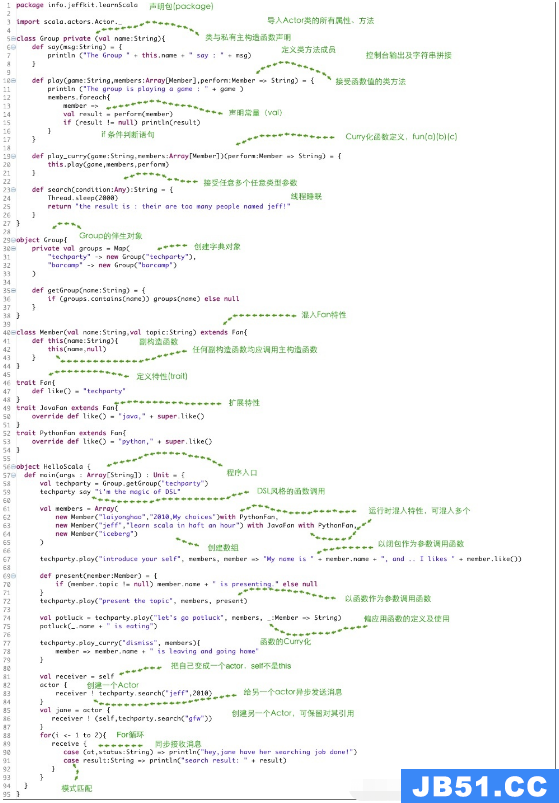我想我还不完全了解
scalaz Futures的工作原理.我正在尝试将一个项目从scala期货移植到scalaz实现,但问题是scalaz Future的性能较低.最简单的示例是使用Spray在身份验证请求上加载配置文件.
功能本身:
def loadProfile[A: CollectionProvider: JsonFormat](id: String) = future {
remote.findOne[A]("id" :> id) match {
case Some(profile) ⇒ \/-(profile)
case None ⇒ -\/(ProfileNotFoundRejection(id))
}
}
scalaz版本只有一个符号,我从scalaz.concurrent调用Future.apply.
现在加载一些html页面的Spray路由:
get {
path("profile" / "id" ~ Segment) { id ⇒
onSuccess(loadProfile[User](id)) {
case \/-(profile) ⇒ complete(html.page(profile))
case -\/(pnfr) ⇒ reject(pnfr)
}
}
}
与loadProfile一样,scalaz版本仅在方法调用中有所不同:
get {
path("profile" / "id" ~ Segment) { id ⇒
ctx => loadProfile[User](id).runAsync {
case \/-(profile) ⇒ ctx.complete(html.page(profile))
case -\/(pnfr) ⇒ ctx.reject(pnfr)
}
}
}
但是scala Future版本的请求在(大约)143ms内完成,而scalaz版本在260ms内完成.所以我不太关心这个特殊的请求,但关于异步执行和服务的可伸缩性一般来说,正如我在scalaz中所理解的那样Future我必须手动将执行分叉到一个单独的线程,所以它按顺序执行? scalaz的未来用法是否有任何好的介绍/教程?
解决方法
斯卡拉和斯卡拉斯期货非常不同:
斯卡拉
import scala.concurrent._
import scala.concurrent.ExecutionContext.Implicits._
// creating two slow futures:
val f: Future[Unit] = Future { println("f " + Thread.currentThread().getName()); Thread.sleep(10000); }
val g: Future[Unit] = Future { println("g " + Thread.currentThread().getName()); Thread.sleep(10000); }
// and after moment asking for success
f onSuccess { case _ => println("f s1 " + Thread.currentThread().getName()) }
g onSuccess { case _ => println("g s1 " + Thread.currentThread().getName()) }
f onSuccess { case _ => println("f s2 " + Thread.currentThread().getName()) }
g onSuccess { case _ => println("g s2 " + Thread.currentThread().getName()) }
我们在创建f和g之后立即获得输出
f ForkJoinPool-1-worker-5 g ForkJoinPool-1-worker-3
约10秒后休息输出
f s1 ForkJoinPool-1-worker-5 g s1 ForkJoinPool-1-worker-5 f s2 ForkJoinPool-1-worker-5 g s2 ForkJoinPool-1-worker-5
Scalaz
import scalaz.concurrent._ // z!
import scala.concurrent.ExecutionContext.Implicits._
// creating two slow futures:
val f: Future[Unit] = Future { println("f " + Thread.currentThread().getName()); Thread.sleep(10000); }
val g: Future[Unit] = Future { println("g " + Thread.currentThread().getName()); Thread.sleep(10000); }
创建f和g后,没有任何反应.我们有:
f: scalaz.concurrent.Future[Unit] = Async(<function1>) g: scalaz.concurrent.Future[Unit] = Async(<function1>)
但在运行它们后,我们看到了不同之处:
f runAsync { _ => println("f s1 " + Thread.currentThread().getName()) }
g runAsync { _ => println("g s1 " + Thread.currentThread().getName()) }
f runAsync { _ => println("f s2 " + Thread.currentThread().getName()) }
g runAsync { _ => println("g s2 " + Thread.currentThread().getName()) }
我们得到结果:
f pool-4-thread-2 g pool-4-thread-1 f pool-4-thread-4 g pool-4-thread-3 f s2 pool-4-thread-4 g s2 pool-4-thread-3 g s1 pool-4-thread-1 f s1 pool-4-thread-2
有两点值得一提:
>期货f和g再次执行.没有价值记忆.
> runAsync回调在与第一次计算相同的线程中执行.这是因为我们没有明确地分叉.
很难说为什么他们在你的例子中表现不同.无论如何,最多的时间应该花在remove.findOne上.您希望使用scala.concurrent.blocking来阻止调用,以帮助ExecutorService不会遇到线程饥饿(在这两种情况下).


